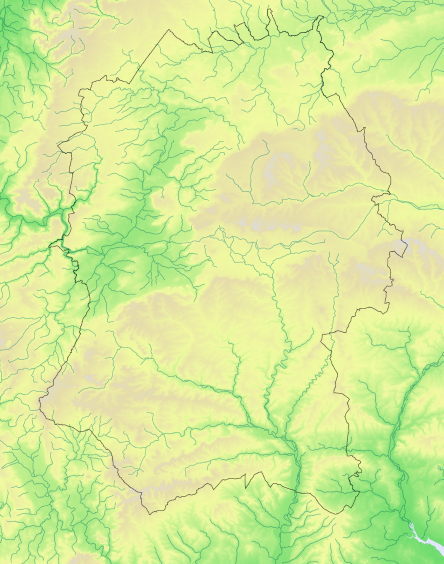Atlas species lists
- Breeding distribution 1995–2000
- Summer abundance 1995–2000
- Winter distribution 1995–2000
- Winter abundance 1995–2000
- Breeding distribution 2007–2012
- Summer abundance 2007–2012
- Winter distribution 2007–2012
- Winter abundance 2007–2012
- Breeding distribution change
- Summer abundance change
- Winter distribution change
- Winter abundance change
More Great Bustard maps
- Breeding distribution 1995–2000
- Summer abundance 1995–2000
- Winter distribution 1995–2000
- Winter abundance 1995–2000
- Breeding distribution 2007–2012
- Summer abundance 2007–2012
- Winter distribution 2007–2012
- Winter abundance 2007–2012
- Breeding distribution change
- Summer abundance change
- Winter distribution change
- Winter abundance change
More maps for this atlas
Map explanation
This map shows the winter relative abundance of the species in Wiltshire, based on variation from the average, as revealed by the fieldwork for Birds of Wiltshire (Wiltshire Ornithological Society 2007).
Key
Data not mapped to preserve confidentiality
Great Bustards have a range stretching across Eurasia from Iberia and Morocco in the west to China in the east, though their distribution is very fragmented. The species has undergone a sustained, long-term decline, especially since the early 19th century. It is only in the past 20 years that the decline has been slowed by major conservation action in many countries; the world population has now stabilised.
Great Britain was an extreme example of this general pattern. Up until the 18th century Great Bustards nested in at least ten English counties and even in southeast Scotland. But changes in agricultural practices and shooting (by trophy-hunters and for the pot) combined to drive the British population to extinction by the early years of the 19th century. The last British breeding records were in Norfolk in 1830 and Suffolk in 1832.
In Wiltshire Salisbury Plain had been one of the Great Bustard's strongholds - there were reports of flocks of 50 or more in the mid 18th century - but by the early 19th century they were all gone. The last recorded nest was in a wheatfield near Market Lavington in 1801. There were reports of some birds lingering on for the next decade or so but no further recorded evidence of breeding. There were a few isolated records throughout the 19th century, almost certainly of winter vagrants from the Continent all of which ended up being shot. The last one in Wiltshire was shot near Chippenham in 1891.
Thereafter there were no further Great Bustards seen in Wiltshire until the start of re-introduction programmes in the late 20th century. The first of these, carried out by the specially created Great Bustard Trust on Porton Down in the 1970s and 1980s, was unsuccessful. But lessons were learned and a successor organisation, the Great Bustard Group, was set up in 1998 and, drawing on advice from the IUCN's Bustard Specialist Group, is beginning to achieve some success in rearing young birds. Initially these were imported as chicks from east Europe but subsequently the project has switched to eggs brought in from Spain and incubated locally. In the fieldwork for Bird Atlas 2007-2011 Great Bustards were recorded at eight sites away from the project area during the breeding season and also eight, mostly different, sites in winter. Wiltshire reared birds have also been recorded in Somerset and Gloucestershire.
References
The following references are used throughout these species accounts, in the abbreviated form given in quotation marks:
“1968-72 Breeding Atlas” – Sharrack, J.T.R. 1976: The Atlas of Breeding Birds in Britain and Ireland. T. & A. Poyser
“1981-84 Winter Atlas” – Lack, P.C. 1986: The Atlas of Wintering Birds in Britain and Ireland. T. & A. Poyser
“1988-91 Breeding Atlas” – Gibbons, D.W., Reid, J.B. & Chapman, R.A. 1993: The New Atlas of Breeding Birds in Britain and Ireland 1988-91. T. & A. Poyser
“Birds of Wiltshire” – Ferguson-Lees, I.J. et al. 2007 : Birds of Wiltshire, published by the tetrad atlas group of the Wiltshire Ornithological Society after mapping fieldwork 1995-2000. Wiltshire Ornithological Society.
“Bird Atlas 2007-2011” – Balmer, D.E., Gillings, S., Caffrey, B.J., Swann, R.L., Downie, I.S. and Fuller, R.J. 2013: Bird Atlas 2007-2011: the Breeding and Wintering Birds of Britain and Ireland
“WTA2” – ("Wiltshire Tetrad Atlas 2 ") the present electronic publication, bringing together the Wiltshire data from “Birds of Wiltshire” and “Bird Atlas 2007-11”, together with data from further fieldwork carried out in 2011 and 2012.
"Hobby" - the annual bird report of the Wiltshire Ornithological Society.

